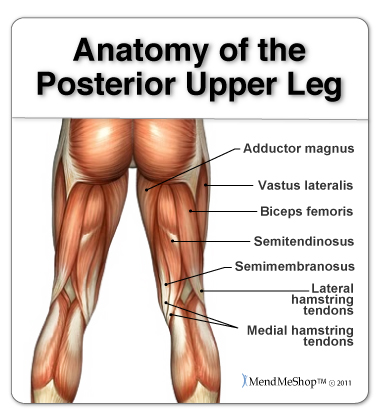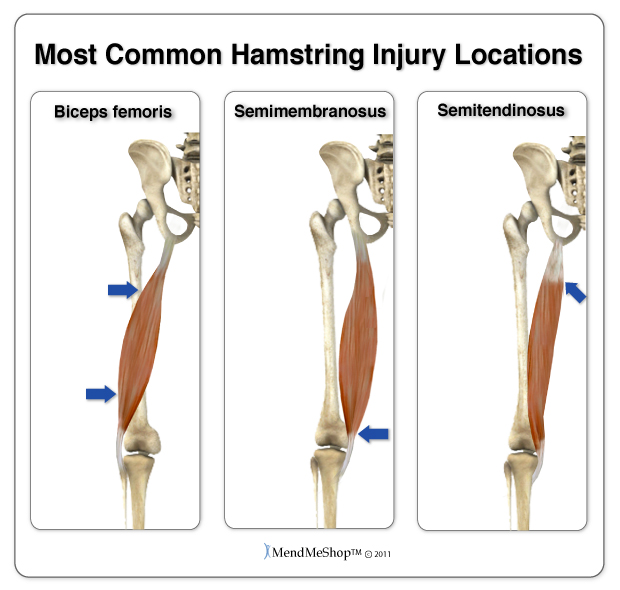The hamstrings are not regularly used in common everyday motions like walking and standing, therefore, individuals who are not very active may not notice if they have weak hamstring muscles.
However, well conditioned and flexible hamstring muscles are very important to athletes to stabilize the knees and prevent hamstring pain and hamstring injury.
The hamstrings refer to 3 long posterior leg muscles, the biceps femoris, semitendinosus, and semimembranosus. These muscles start at the bottom of your pelvis extending down the back of your thigh and along either side of your knee, to your lower leg bones.
The lateral hamstring is the biceps femoris (made up of 2 parts - a short head and long head) and the medial hamstrings are the semitendinosus (joins the sartorius muscle and gracilis muscle at the pes anserinus on the tibia) and the semimembranosus (the largest hamstring muscle). The tendons for these muscles begin at your ischial tuberosity, or ischium (the bony bump under each buttock), and attach on the outer edges of your shinbones (tibia and fibula) just below the back of your knee.
The posterior upper leg muscles provide your knees with mobility (extension, flexion and rotation) and strength. They work closely with your quadriceps muscles at the front of your thigh, your gluteal muscles, and your calf muscles to ensure proper movement of your leg and hip.


Your hamstring muscles control movement of your torso, hips and knees, help turn your legs in and out, and are involved with power activities that include a lot of propulsion, thrust and control (such as jumping, climbing, and running). They allow your knee to bend (flex the leg at the knee) and pull your leg backward while propelling your body forward when you move (your thigh straightens and extends the leg back at the hip). They are involved with eccentric movements, which increase the length of the muscle while it is under tension - instead of starting an action, the muscles act as a brake to stop an action. You can feel this when walking or running downhill, landing from jumps or performing squats, and when trying to stop quickly after sprinting.

The biceps femoris hamstring muscle is the most frequently injured, as it suffers the largest stretch during sprinting, followed by the semitendinosus muscle. If you have a multi-muscle injury, it normally occurs at the point where your hamstring muscles and tendons meet (musculotendinous junction) at the top of the hamstring muscles. However, hamstring pulls can also occur at any place along the hamstring muscle bellies or in the tendons that attach the muscles to the bones.
Hamstring injuries can be frustrating to live with and difficult to healing. The healing process takes time and you may find it difficult to give your leg the rest it needs. This is especially true for runners and other athletes that return to their sport too early. Re-injury is common but it prolongs recovery and may also lead to permanent damage and other conditions.
Treating your hamstring injury correctly is essential to getting rid of your pain and restoring function to your hamstring muscles and tendons. Proper treatment will get you back to regular activities sooner, stop your pain, and reduce the risk of future re-injury.
To restore strength and range of motion in your hamstrings, treatment should focus on preventing scar tissue formation and muscle atrophy (shrinkage and weakening of the muscle). This requires rest and the appropriate therapies at the right time. Almost all types of hamstring pulls and tears (except a complete hamstring rupture) can be properly treated with trusted therapies that are available for use at home. Complete ruptures usually require surgery. However, using these home therapies after surgery can help speed recovery, improve function, and increase range of motion in your hamstrings.
AidYourHamstring advisors do not work on commission, so be assured you will only receive fair and objective information.
Product Advisors are available 9:00 am to 5:00 pm Eastern Standard Time Monday to Friday.
I want to learn more about Surgery & Post-Surgery Recovery
I want to learn more about Circulation Boost
I want to learn more about Ice & Heat: Which Is Better For Treatment?
I want to learn more about Stretching for the Hamstring
I want to learn more about Soft Tissue Injury Treatments
During your recovery, you will probably have to modify and/or eliminate any activities that cause pain or discomfort at the location of your soft tissue injury until the pain and inflammation settle. The more diligent you are with your treatment and rehabilitation, the faster you will see successful results!
Please be aware that this information is neither intended nor implied to be a substitute for professional medical advice. CALL YOUR HEALTHCARE PROVIDER IMMEDIATELY IF YOU THINK YOU MAY HAVE A MEDICAL EMERGENCY. Always seek the advice of your physician or other qualified health provider before using any of our outstanding products to make sure they are right for you and your condition or if you have any questions regarding a medical condition. Always see your doctor for a proper diagnosis as there are often many injuries and conditions (some very serious) that could be the cause of your pain.
© 2025 In.Genu Design Group, Inc. Contact Us